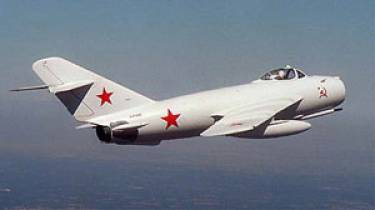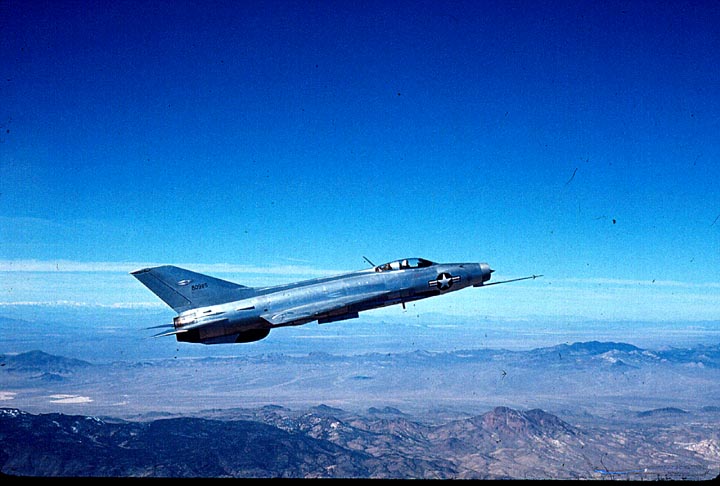


 |
 |
 |
 |
The photos on this page were taken during the MiG projects at Area 51 and have been declassified for public view.
In the late 1960's, the U.S. Navy, Air Force, and a number of U.S. federal agencies undertook a program at Groom Lake to evaluate the MiG-17 to help fight the Vietnam War during a period of anti-Vietnam War protests and the North Vietnamese MiG-17s and MiG-21s having a kill rate against the U.S. air assets was 9:1. These programs were code-named HAVE DRILL and HAVE FERRY under The Defense Intelligence Agency Project "HAVE DRILL." At Groom Lake a small, highly specialized group of engineers and technicians had just wrapped up the CIA's A-12 Oxcart program and continued on for Projects HAVE DRILL and HAVE FERRY involving trials of MiG-17F Frescos over the skies of Area 51 at Groom Lake, and Project DOUGHNUT, an USAF evaluation of the MiG 21. In addition to tracking the dog fights staged between the various MiG models against virtually every fighter in U.S. service, and against SAC's B-52 Stratofortress and B-58 Hustlers to judge the ability of the bombers’ countermeasures systems, they performed radar cross-section and propulsion tests that contributed greatly to improvements in U.S. aerial performance in Vietnam. This group was, during this period, also involved in the early stages of Projects HAVE BLUE (stealth) "SENIOR TREND" (F-117), and TACIT BLUE. What was learned during these projects at Area 51 prompted the U.S. Navy to commence Top Gun Weapons School first at Miramar, California and then Fallon, Nevada. Shortly thereafter the U.S. Air Force commenced its Red Flag exercises at Nellis AFB, Nevada.
DRILL." At Groom Lake a small, highly specialized group of engineers and technicians had just wrapped up the CIA's A-12 Oxcart program and continued on for Projects HAVE DRILL and HAVE FERRY involving trials of MiG-17F Frescos over the skies of Area 51 at Groom Lake, and Project DOUGHNUT, an USAF evaluation of the MiG 21. In addition to tracking the dog fights staged between the various MiG models against virtually every fighter in U.S. service, and against SAC's B-52 Stratofortress and B-58 Hustlers to judge the ability of the bombers’ countermeasures systems, they performed radar cross-section and propulsion tests that contributed greatly to improvements in U.S. aerial performance in Vietnam. This group was, during this period, also involved in the early stages of Projects HAVE BLUE (stealth) "SENIOR TREND" (F-117), and TACIT BLUE. What was learned during these projects at Area 51 prompted the U.S. Navy to commence Top Gun Weapons School first at Miramar, California and then Fallon, Nevada. Shortly thereafter the U.S. Air Force commenced its Red Flag exercises at Nellis AFB, Nevada.
|
THE MIKOYAN-GUREVICH (MiG) 17 FRESCO |
 |
The MiG-17 (NATO code name Fresco) was the first Soviet fighter to have an afterburning engine, the Klimov VK-1. Although similar in appearance to the MiG-15, the MiG-17 has more sharply swept wings, an afterburner, better speed and handling characteristics and is about three feet longer. The wings of the aircraft are mid-mounted, swept-back, and tapered with blunt tips. They have wide wing roots. The engine is one turbojet inside the body and has a round air intake in the nose. It has a single, small exhaust. The fuselage is short, thick, cigar-shaped and tapered to the rear. It has a blunt nose and bubble canopy. The tail fin is swept-back and tapered with rounded tip. Flats are high-mounted on the tail fin, swept-back, and tapered. Flats and fin overhang the exhaust. The MiG-17PFU was armed with four AA-1 "Alkali" radar-guided missiles, making it the Soviet Union's first missile armed interceptor. See declassified photos below.
|
THE MIKOYAN-GUREVICH (MiG) 21 FISHBED |

The MiG-21 Fishbed is the most built jet ever. Fast, small, agile dependable, and above all simple, this swept-wing MiG design called "Faceplate" by NATO was turned out in prodigious numbers, flooding the skies above Europe, Asia, Africa, and even Central America with literally thousands of modern, deadly fighters. It has flown in more wars than any other airplane in the world, over 10,000 of them produced by the Soviet Union, it's allies and China with a 30-year record equal, and parallel, to the McDonnell Douglas F-4 Phantom II.
The MiG-21 prowess isn't its target capabilities or range. Known as a pilot's plane partially because it doesn't have any computers or fancy navigation equipment, the swept-wing Fishbed depended on the pilot's training and experience. Though this lack of technology might be termed the MiG-21's Achilles verse, it certainly shocked the Phantom pilots when it arrived in the skies over Vietnam and proved itself over and over as a formidable dogfighter against the heavier American fighters, which was another reason for the success of the MiG-21. An analog to the F-104 in that it is a Mach-2 fighter, its reliable engine, easy maintenance, rough field capabilities, and safe flight characteristic made it the most successful jet aircraft of all times. See declassified photos below.
|
MiG-21 FISHBED |
The MiG-21F is a short-range day fighter-interceptor and the first major production version of the popular MiG-21 series. It is but one of many versions of this aircraft that have served in the air arms of many nations around the world. The E-5 prototype of the MiG-21 was first flown in 1955 and made its first public appearance during the Soviet Aviation Day display at Moscow's Tushino Airport in June 1956. During the Vietnam War, MiG-21s were often used against U.S. aircraft. Between April 26, 165, and January 8, 1973, USAF F-4s and B-52s downed 68 MiG-21s. More than 30 countries of the world-including nations friendly to the U.S. -have flown the MiG-21. At least 15 versions of the MiG-21 have been produced, some outside the Soviet Union. Estimates place the number built at more than 8,000, a production total exceeding that of any other modern jet aircraft.
The aircraft has mid-mounted delta wings with small square tips. There is one turbojet inside the body. There is a small round air intake in the nose. There is a single exhaust. The fuselage is a long, tubular body with a blunt nose and bubble canopy. There is one belly fin under the rear section. There is a large dorsal spine flush with the canopy. The tail fin swept-back and tapered with a square tip. The flats are mid-mounted on the body, swept-back, and tapered with square tips. The J-7FS modification adds a radar to a reconfigured air intake, while the "Super 7" upgrade would have completely reworked the front end of the aircraft, adding a much larger radar and ventral air inlets, along with various other less pronounced improvements.
MiG-21 aircraft acquired by the United States under the Foreign Materiel Acquisition/Exploitation program are designated as the YF-110.
In the former USSR this aircraft was manufactured between the late 50s and the middle 70s. The MiG-21 is the world champion in the number of the air vehicles produced (11,000) and in airframe service life (up to 30 years). That is why about 3,000 MiG-21 are now operated by the air forces of more than 40 countries. The MiG-21 is close to setting another world record in the amount of the upgraded aircraft.
MiG-21MF is a single-engine, single-seat supersonic jet fighter designed primarily for destruction of air targets by guided and non-guided weaponry and for air reconnaissance. To a certain extent, the aircraft can also be used for destruction of ground targets. A two-seat modification MiG-21UM is designed for advanced and perfection training of pilots for MiG-21 types. MiG-21MF (NATO reporting name Fishbed-J) represents the first third generation interceptor/fighter designed to gain and maintain air superiority. It was developed as a universal type to fulfill fighter tasks and multipurpose fighter/bomber tasks with limited possibilities in adverse weather conditions. It is equipped with the R-13F-300 engine with additional combustion, and the RP-22S radar. This type of MiG-21MF was manufactured in 1974 to 1975. Capacity of the internal fuel tanks is 2650 litres. The aircraft can be equipped with an optional external fuel tank under the fuselage and two tanks under the wings with a total capacity of 1470 litres. As to missiles, it can carry R-13A, R-60 and R-MK short-range air-to-air missiles. Standard equipment is the 23mm GSh-23L gun. MiG-21MF can also be used for air support of ground forces. In such case it can carry UB-16-57 or UB-32A launcher tubes, 240 mm S-24 air-to-surface rockets, or bombs up to 500 kg.
The upgrade project offered by RAC "MiG" and named MiG-21-93 is based on the use of "Kopyo" ("Spear") airborne radar, new weapons and equipment. This project has been developed jointly by RAC "MiG", Phazotron-NIIR Company, GosNIIAS and "Sokol" Joint-Stock Company under the general patronage of "Rosvooruzhenye" company. Due to high technical characteristics and reasonable cost, the project has won the Indian tender for MiG-21 fleet retrofitting. The "Kopyo" radar is designed for controlling the full aircraft weapons spectrum: built-in gun, rockets, advanced missiles with homing heads and guided bombs. This makes it possible to enhance qualitatively the MiG-21 following characteristics:
air target detection and lock-on range both in look-up and look-down with using R-27 and RVV-AE middle-range missiles ( the latter can be launched against several targets simultaneously); ground and sea-surface target detection and improved communication, EW and navigation aids; air target detection and engagement range in action in the front hemisphere; improved guidance and engagement capabilities in action against ground targets of any type; track-while-scan mode with the capability of tracking up to 10 targets and engaging two of them; capability to battle successfully with forth-generation fighters; effective destruction of ground targets covered by enemy air defense. In accordance with the Indian party request, a number of systems of Western and Indian make have been combined in a single avionics complex. The main objective of the MiG-21-93 project is to achieve the maximum combat effectiveness with minimum aircraft changes and extend the service life of this reliable aircraft (up to 40 years and 4,000 flying hours). Also, this rational approach to MiG-21 upgrade allows the Customer to save great funds to the utmost. Essentially the tests of the aircraft have been completed and the series production of the upgraded MiG-21bis aircraft for the Indian Air Force has been launched.
Sources and Resources
JOHN T. MANCLARK November 1985 - November 1987, squadron commander, 4477th Test and Evaluation Squadron, Nellis Air Force Base, Nev. -- Aircraft flown: T-38, F-4C/D/E, F-5E, YF-110 and YF-113
COLONEL "HAWK" CARLISLE - December 1986 - December 1988, chief of weapons and tactics and flight commander, 4477th Test and Evaluation Squadron, Nellis Air Force Base, Nev. Aircraft flown: AT-38, YF-110, YF-113, T-38, F-15
J-7 @ pakmilitary.com Shenyang and Chengdu J-7 @ Encyclopedia of World Military Aircraft
 |
 |
 |
 |
 |
 |
 |
|||
 |
 |
 |
 |
 |
 |
 |
 |
 |
 |
 |
 |
 |
 |
 |
 |
 |
 |
 |
 |
 |
 |
 |
 |
 |
 |
 |
 |
||
 |
 |
 |
 |
 |
 |
 |
 |
 |
|
 |
 |
 |
 |
 |
 |
 |
 |
 |
|
 |
 |
 |
 |
 |
 |
 |
 |
 |
 |
 |
 |
 |
 |
 |
 |
 |
 |
 |
 |
 |
 |
 |
 |
 |
 |
 |
 |
 |
 |
 |
 |
 |
 |
||||||
 |
 |
 |
 |
 |
 |